MEDLINE is a bibliographic database of life sciences and biomedical information. It includes bibliographic information for articles from academic journals covering medicine, nursing, pharmacy, dentistry, veterinary medicine, and health care. MEDLINE also covers much of the literature in biology and biochemistry, as well as fields such as molecular evolution.
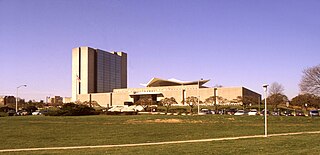
The United States National Library of Medicine (NLM), operated by the United States federal government, is the world's largest medical library.
PubMed is a free search engine accessing primarily the MEDLINE database of references and abstracts on life sciences and biomedical topics. The United States National Library of Medicine (NLM) at the National Institutes of Health maintain the database as part of the Entrez system of information retrieval.

Medical Subject Headings (MeSH) is a comprehensive controlled vocabulary for the purpose of indexing journal articles and books in the life sciences. It serves as a thesaurus that facilitates searching. Created and updated by the United States National Library of Medicine (NLM), it is used by the MEDLINE/PubMed article database and by NLM's catalog of book holdings. MeSH is also used by ClinicalTrials.gov registry to classify which diseases are studied by trials registered in ClinicalTrials.
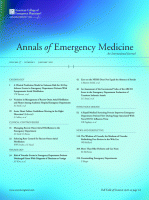
The Annals of Emergency Medicine is a monthly peer-reviewed medical journal covering all aspects of emergency medicine care. It is the official journal of the American College of Emergency Physicians (ACEP) and is published on their behalf by Elsevier. The editor-in-chief is Donald M. Yealy. It was established in 1972 as the Journal of the American College of Emergency Physicians and obtained its current title in 1980.

JAMA Internal Medicine is a monthly peer-reviewed medical journal published by the American Medical Association. It was established in 1908 as the Archives of Internal Medicine and obtained its current title in 2013. It covers all aspects of internal medicine, including cardiovascular disease, geriatrics, infectious disease, gastroenterology, endocrinology, allergy, and immunology. The editor in chief is Rita F. Redberg.

JAMA Neurology is a monthly peer-reviewed medical journal published by the American Medical Association. It was established in 1960 as Archives of Neurology and obtained its current name in 2013. The journal publishes research on the nervous system as well as the various mechanisms of neurological disease. Its editor-in-chief is S. Andrew Josephson.
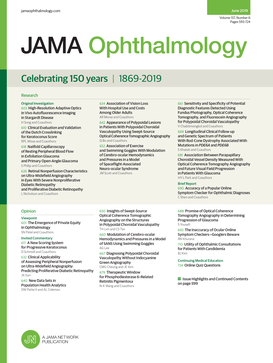
JAMA Ophthalmology is a monthly peer-reviewed medical journal covering all aspects of ophthalmology. The editor-in-chief is Neil M. Bressler. It is published by the American Medical Association, with which it has been affiliated since 1929.
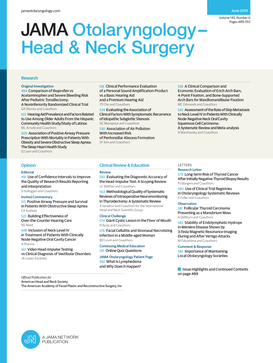
JAMA Otolaryngology—Head & Neck Surgery is a monthly peer-reviewed medical journal published by the American Medical Association and covering all aspects of prevention, diagnosis, and treatment of diseases of the head, neck, ear, nose, and throat. The editor-in-chief is Jay F. Piccirillo. It was established in 1925 as the Archives of Otolaryngology and renamed A.M.A. Archives of Otolaryngology in 1950, then renamed Archives of Otolaryngology–Head & Neck Surgery in 1960, before obtaining its current name in 2013.
JAMA Pediatrics is a monthly peer-reviewed medical journal published by the American Medical Association. It covers all aspects of pediatrics. The journal was established in 1911 as the American Journal of Diseases of Children and renamed in 1994 to Archives of Pediatrics & Adolescent Medicine, before obtaining its current title in 2013.
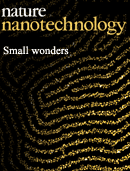
Nature Nanotechnology is a monthly peer-reviewed scientific journal published by Nature Publishing Group. It was established in October 2006. The editor-in-chief is Alberto Moscatelli. It covers all aspects of nanoscience and nanotechnology.
The Vancouver system, also known as Vancouver reference style or the author–number system, is a citation style that uses numbers within the text that refer to numbered entries in the reference list. It is popular in the physical sciences and is one of two referencing systems normally used in medicine, the other being the author–date, or "Harvard", system. Vancouver style is used by MEDLINE and PubMed.

Clinical Microbiology Reviews is a peer-reviewed medical journal covering the areas of clinical microbiology, immunology, medical microbiology, infectious diseases, veterinary microbiology, and microbial pathogenesis. It is a delayed open access journal, full content is accessible via PubMed Central and the journal's website after a 12-month embargo. In April 2015, the journal transitioned to a continuous online publication model. The journal became online-only in January 2018. The final print issue was published in October 2017. According to the Journal Citation Reports, the journal has a 2021 impact factor of 50.129. The journal was established in January 1988. The founding editor was Josephine A. Morello. Editorial board structure changed in 1992 and Morello became editor-in-chief. Betty Ann Forbes was appointed editor-in-chief in 1997. Irving Nachamkin was appointed editor-in-chief in 2002 until 2012. Jo-Anne H. Young served as editor-in-chief from 2012 to 2022. The current editor-in-chief is Graeme Forrest. It is the ninth journal established and published by the American Society for Microbiology.

The Journal of Clinical Microbiology is a monthly medical journal published by the American Society for Microbiology. The journal was established in 1975. The editor-in-chief is Alexander J. McAdam. It is a delayed open access journal. Full text content is available free after a six-month embargo.

The Journal of Rehabilitation Research and Development was a peer-reviewed open access medical journal published by the Rehabilitation Research and Development Service of the Veterans Health Administration Office of Research and Development. It covered research on rehabilitation medicine. It published ten issues in print and electronic formats each year. The journal's website contains the full archive dating back to 1964. The journal was established in 1964 as the Bulletin of Prosthetics Research, obtaining its latest name in 1983. In 2017, the journal announced that it would cease publication, to be replaced with a community organised through the open access publisher PLOS.
The American Journal of Orthodontics and Dentofacial Orthopedics is a monthly peer-reviewed medical journal covering orthodontic research. It is published by Elsevier and is the official journal of the American Association of Orthodontists. The editor-in-chief is Rolf G. Behrents. The journal was established in 1915 and obtained its current name in 1986. Previous names include American Journal of Orthodontics and American Journal of Orthodontics and Oral Surgery.
Citing Medicine: The NLM Style Guide for Authors, Editors, and Publishers is the style guide of the United States National Library of Medicine (NLM). Its main focus is citation style and bibliographic style. The citation style of Citing Medicine is the current incarnation of the Vancouver system, per the References > Style and Format section of the ICMJE Recommendations. Citing Medicine style is the style used by MEDLINE and PubMed.
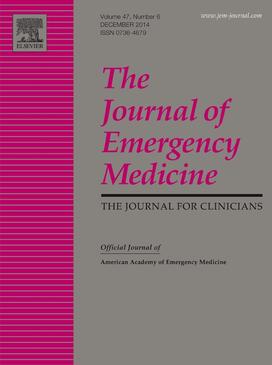
The Journal of Emergency Medicine is a monthly peer-reviewed medical journal covering emergency medicine. It is the official journal of the American Academy of Emergency Medicine. The editor-in-chief is Stephen Hayden. The founding editor was Peter Rosen and it is published by Elsevier. It was established in 1983 and originally published by Pergamon Press. The journal is often referred to by its acronym, JEM.
The Saudi Medical Journal is a monthly peer-reviewed medical journal. It is an open access journal, with content released under a Creative Commons attribution-noncommercial license.
The National Library of Medicine Technical Bulletin is a public domain information newsletter of the Office of Engagement and Training, United States National Library of Medicine (NLM). The newsletter contains current news and information for NLM products and services, listings for NLM events, and update notes for NLM offerings, including PubMed, MEDLINE, and MeSH.












